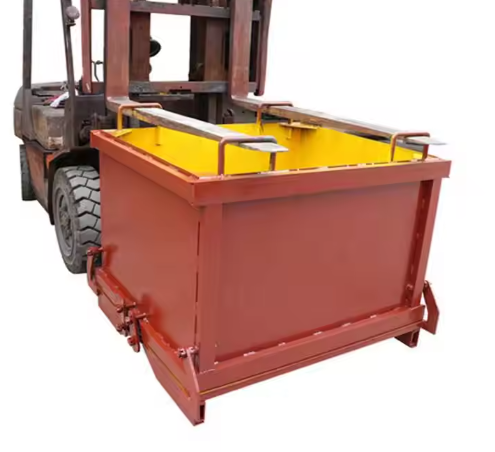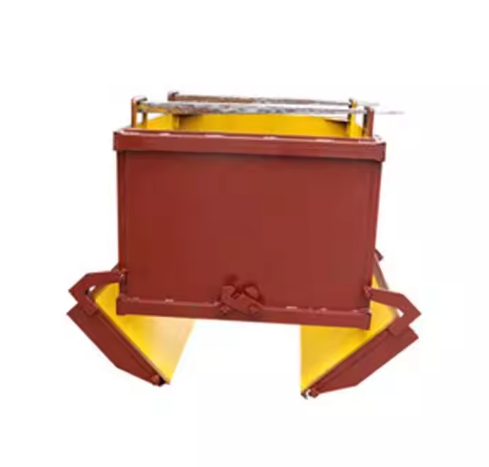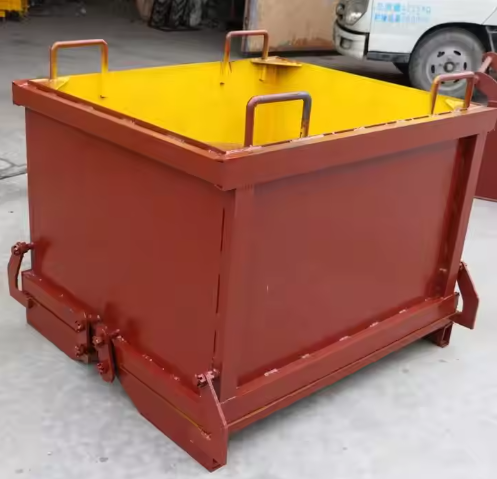
The important role of stone waste containers in environmental protection and resource recycling
With the continuous improvement of global environmental awareness, more and more industries have begun to pay attention to sustainable development, especially the stone industry, which consumes a lot of resources. In the process of stone processing, the generation of waste is inevitable. These wastes not only take up a lot of space, but also may pollute the environment. Therefore, how to effectively deal with stone waste has become an important issue in the industry. As an environmentally friendly and innovative product, stone waste containers provide a feasible solution to this problem. This article will explore the role, design and importance of stone waste containers in the modern stone industry.

Forklift waste bin waste bin stone waste bin
The role of stone waste containers
The primary function of stone waste containers is to collect and store waste generated during stone processing. During stone processing, due to operations such as cutting, grinding, and polishing, a large amount of waste such as crushed stone, scraps and dust is often generated. If these wastes are not effectively managed, they will often be scattered around the factory or construction site, which not only increases the risk of environmental pollution, but also affects production efficiency. Stone waste containers effectively prevent the spread of waste by collecting these wastes in a centralized manner, and can be uniformly processed or recycled when needed.
In addition, stone waste containers can also reduce the impact of waste on the environment to a certain extent. In particular, some stone waste may contain harmful substances, such as mineral dust or chemicals, which may pollute the air and water sources if not collected and treated in time. Collecting waste through containers with good sealing can avoid the leakage of these pollutants, thereby effectively protecting the environment.
Design concept of stone waste container
The design of stone waste containers needs to take into account multiple factors, the first of which is its durability and sturdiness. Stone waste is usually heavy, especially large pieces of waste, which puts high demands on the material and structure of the container. The container must not only be able to withstand the weight of the waste, but also be able to withstand long-term use and harsh working environments. In order to ensure the sturdiness of the container, many stone waste containers use durable materials such as metal or reinforced plastics to cope with heavy loads and reduce damage.
Secondly, sealing is another design focus. Stone waste is sometimes accompanied by dust or tiny particles. If the sealing performance of the container is not good, the waste may be spread into the air during transportation or storage, causing pollution. Therefore, the design of stone waste containers often adds sealing strips or adopts a closed design to ensure that the storage of waste does not affect the surrounding environment.
In addition, the capacity and classification function of stone waste containers also need to be optimized according to the type of waste. In stone processing, the types and forms of waste vary. Some may be large pieces of stone, while others may be fine dust or particles. Different types of waste require different storage methods, and the container should have certain classification functions to facilitate the subsequent treatment and recycling of waste. For large stone processing plants, designing a container that adapts to different types of waste can not only improve the utilization rate of waste, but also effectively reduce environmental pollution.
Application scenarios of stone waste containers
The application of stone waste containers is mainly concentrated in places such as stone processing plants, construction sites, and waste treatment centers. In these places, efficient management and treatment of waste not only helps to improve production efficiency, but also helps to reduce environmental burden. In stone processing plants, the role of waste containers is particularly important. During the processing process, a large amount of stone waste needs to be collected through special containers. Without suitable waste containers, waste will be scattered in the production workshop or external environment, which will not only affect the cleanliness and production efficiency of the factory, but also threaten the safety and health of workers.
In construction sites, especially in some large-scale construction projects, the use of stone waste containers is also indispensable. Construction sites often need to handle a large amount of stone and building materials, and the waste generated during the cutting and installation of these materials must also be collected and processed in a timely manner. Suitable stone waste containers can not only effectively improve the collection efficiency of waste, but also reduce pollution on the construction site, improve the construction site environment, and meet the high standards of environmental protection in the modern construction industry.
Waste treatment center is one of the important application areas of stone waste containers. In waste treatment centers, waste containers are not only used to store stone waste, but also need to undertake tasks such as waste sorting, recycling and reuse. These containers usually need to have higher capacity and stronger sorting functions to cope with the collection and treatment of large amounts of waste.

Stone Waster Containers(Dumpster)
The environmental significance of stone waste containers
As the world’s attention to sustainable development and environmental protection continues to increase, the environmental pressure on the stone industry is also increasing. The disorderly discharge of stone waste not only wastes precious resources, but also may cause serious pollution to the natural environment. The emergence of stone waste containers provides an important solution for the efficient management of waste and resource recycling.
Through the rational design of stone waste containers, stone processing plants can better manage waste, realize the classified collection of waste, and avoid waste pollution to the environment. In addition, these waste containers also provide conditions for the reuse of stone waste. Many stone wastes, such as scraps and small pieces of crushed stone, can be recycled and reprocessed to produce recycled stone or used in the fields of construction, landscape design, etc., forming a recycling of resources.
The use of stone waste containers not only improves the environmental protection level of the stone industry, but also lays the foundation for the sustainable development of enterprises. With the increasingly stringent environmental protection policies, more and more companies realize that the adoption of environmentally friendly design and equipment is not only in line with the needs of government requirements, but also a reflection of corporate social responsibility and market competitiveness.

Stone Waster Containers
Stone waste containers are not only an important tool for the stone industry to manage waste, but also a key link in environmental protection and resource recycling. In the modern stone processing and construction industry, the effective collection, classification and treatment of waste are essential. Through scientific and reasonable design, stone waste containers can improve the utilization rate of waste, reduce environmental pollution and promote the recycling of resources. With the continuous enhancement of environmental awareness, stone waste containers will play a more important role in the future stone industry, helping the industry achieve green and sustainable development goals.

Henry
Hi, I’m the author of this post, and I have been in this field for more than 16 years. If you need OEM&ODM service for stone tools, feel free to ask me any questions.



